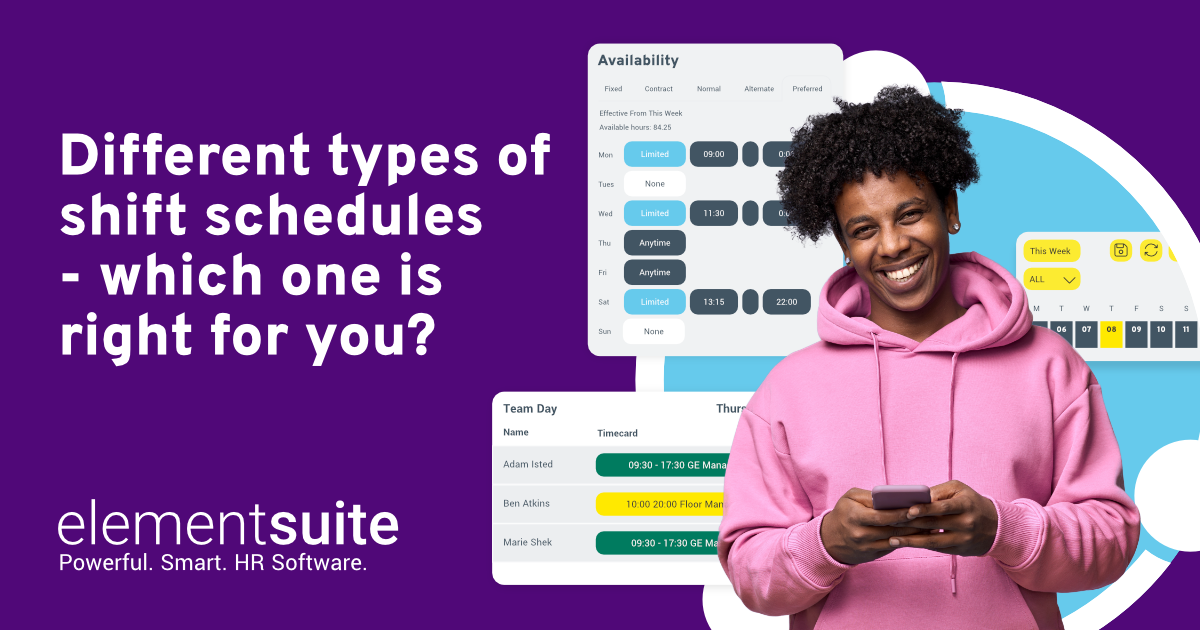Choosing the right shift schedule is not just a matter of operational efficiency, but it is a reflection of your understanding and consideration for your workforce. It enables businesses to operate continuously, provide parity among employees, and meet consumer demands.
Take, for instance, the service and manufacturing industries, both of which operate 24/7 round-the-clock operations. A single day’s work without a suitable shift schedule is unimaginable. Each of the various roles within these industries requires specific coverage times, and shift schedules must be designed accordingly.
To determine which type of shift schedule is right for you, let’s explore some common shift patterns used in businesses:
1. Full-time shift
While in the UK there is no specific number of hours that make up a full-time working schedule, it is usually considered to be around 35 hours per week.
It is worth noting, full-time shifts can vary in length and frequency beyond the traditional 9 AM – 5 PM schedule. For example, there is the 4/10 work schedule, where employees work four ten-hour days each week. This is becoming particularly popular, given the rise of the four-day working week movement gaining traction globally. There are also other variations of full-time shifts, such as the 12-hour shift over a 28-day rotation cycle, often used in healthcare and emergency services.
2. Part-time shift
Part-time shifts offer significant flexibility, allowing employees to work fewer hours than the full-time standard, often with the ability to adjust their work schedules to fit personal commitments and responsibilities. This flexibility can make part-time positions highly attractive, particularly in common industries such as retail, hospitality, and manufacturing, where variable demand and seasonal peaks necessitate adaptable workforce solutions.
However, part-time shifts often come with the drawbacks of reduced income and fewer benefits than full-time roles, alongside potential challenges in ensuring consistent team communication and workflow. Therefore, it’s essential to carefully consider the trade-offs when determining whether a part-time shift schedule is right for your business.
3. Fixed shift
Implementing a fixed shift schedule in the workplace allows employees to work consistent shifts, with predetermined working hours that do not change week to week.
While fixed shifts may not offer the same level of flexibility as other schedules, they do provide stability and consistency for both employees and employers. They aid in simplifying the scheduling process, ensure coverage during critical business hours, and enhance team cohesion by maintaining consistent work groups.
4. Flexible shift
Then, we have flexible shifts, where employees can control work hours and adjust their schedules to fit personal needs. This can include employees opting for available shifts and trading shifts with coworkers to accommodate a personal commitment or preference.
These shifts are very popular within retail and service industries, where employees are often students balancing work with school or other personal commitments, such as dependents. They are also an attractive perk for potential employees looking for work-life balance.
5. Rotating shift
Common in 24/7 industries like healthcare, law enforcement, and manufacturing, rotating shifts mix flexibility and structure. Cycling employees through different shifts—morning, evening, night—this method offers varied work hours.
While it can disrupt sleep patterns and affect health, it distributes premium work hours and days off, boosting morale by avoiding fixed schedules for undesirable hours. It also broadens employees’ skill sets by exposing them to various operational aspects.
Popular schedules include the 3-2-2-3 pattern, with three 12-hour shifts followed by two days off, repeating, ensuring two extra days off. There is also the DuPont schedule, favoured in emergency services, which rotates four crews on eight-hour shifts for a week, followed by a week off.
6. Split shift
A split shift is a schedule in which an employee works two separate shifts within one day, separated by a significant break in between. This type of shift is commonly seen in hospitality roles, where employees work both lunch and dinner shifts with a mid-day break.
While split shifts can lead to controlled employment costs by aligning workforce presence with actual needs, they may not be suitable for employees’ work/life balance with family responsibilities or long commutes. However, when effectively managed, split shifts can offer a flexible working solution that meets both the business’s operational demands and employees’ personal needs.
7. Hybrid shift
For those employees who undergo office work, hybrid shifts can combine traditional in-office hours with remote work days, allowing for flexibility and promoting a healthy work-life balance.
They can be particularly attractive to employees who have personal commitments like childcare or eldercare, allowing them to prioritise their responsibilities while still being able to contribute to their job. They are also a great way to attract top talent from different geographical locations.
8. Seasonal shift
During peak seasons, businesses often employ temporary workers to meet increased demand or to cover for employees taking time off. These shift types are typically temporary and can vary from a few weeks to several months.
While this type of scheduling may offer flexibility for employees seeking part-time work or extra income during specific periods, seasonal shifts can also bring training, coordination, and workforce management challenges.
Scheduling considerations for seasonal shifts must also account for industry variations, as the demand for additional staff can significantly differ from one sector to another. Therefore, effective management involves:
- Understanding the distinct requirements of temporary work schedules.
- Choosing the appropriate shift types to ensure operational efficiency.
- Seamlessly integrating seasonal employees with the existing workforce.
Learn more about why Travelodge chose elementsuite to help forecast staffing needs across 580 UK hotels
9. Night shift
Night shifts—also known as graveyard shifts—are common in healthcare, security, transportation, and manufacturing industries.
They typically run from late evening to early morning, with employees working non-traditional hours. While appealing to some individuals for their higher pay rates and quiet work environment, night shifts can also negatively impact health, social life, and sleep patterns.
Therefore, employers must consider the impact of night shifts on employees’ well-being and offer appropriate support, such as providing break spaces, proper lighting, and access to healthy food options. They should also implement measures to mitigate potential safety hazards during overnight work hours.
10. Overtime shift
Finally, overtime shifts encompass any additional hours worked beyond an employee’s regular schedule. This type of shift is typically offered during peak periods or to cover absences or unexpected surges in demand.
Overtime shifts can benefit both employers and employees, offering increased flexibility for businesses while providing extra income for workers. However, carefully managing and planning overtime hours is crucial to avoid burnout and ensure compliance with the Working Time Directive.
Benefits for employees and employers
Ultimately, there is no right or wrong when deciding on the shift pattern for your business. However, before deciding on the best schedules for you, it is highly advised that you undergo accurate forecasting and budgeting to predict your short, medium, and long-term staffing requirements.
We advise, here, that you integrate your scheduling tool with other business tools (such as your project management tools, booking systems, and accounting platforms) to allow for more accurate forecasting. Then, create a precise ‘shape of day’ workload breakdown to inform your shift pattern choices. Doing so will result in a shift schedule that meets the business’s and its employees’ needs.
Different shift types cater to diverse business needs and industry demands, providing flexibility in employment management, enhancing work-life balance, and contributing significantly to a positive workplace culture for both employers and employees. So, choose your shift pattern wisely and enjoy the benefits of increased productivity, improved staff morale, and more satisfied employees.
If you are looking for an employee scheduling solution that allows you to forecast demand, auto-schedule rotas based on workload, and sync with external systems for accurate real-time reporting, book a demo with elementsuite today.




